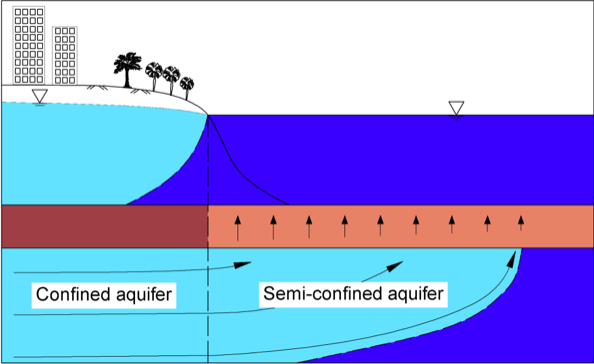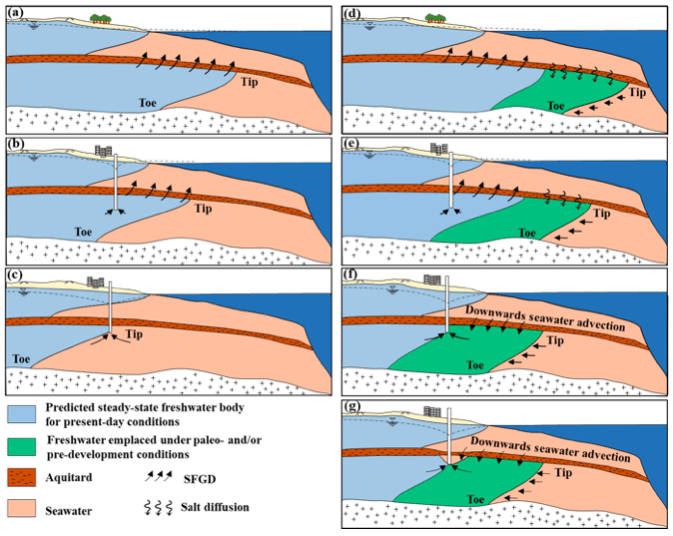
Groundwater beneath the seafloor in many of the world’s continental shelves has salinities well below that of seawater. Increasingly, there is pressure to tap into these subsea freshwater reserves. There are two potential sources of fresh and brackish groundwater in subsea aquifers: (1) entrapped paleo-freshwater emplaced during glacial maxima, when sea levels were lower and continental shelves were exposed, and (2) modern fresh groundwater discharge from onshore aquifers (under current sea-level conditions).
For freshwater to remain in subsea aquifers, a geological sequence of relatively low permeability (i.e., an aquitard) must overly the offshore aquifer to restrict freshwater-seawater mixing. A conceptual model of offshore freshwater groundwater (OFG) created by modern sources is shown in Figure 1.

Figure 1. A conceptual model of offshore fresh groundwater driven by discharge from an onshore aquifer, with upward leakage to the sea through an offshore aquitard (Solórzano-Rivas and Werner, 2018).
The fresh and brackish groundwater trapped beneath the sea amounts to considerable volumes. Post et al. (2013) report values of 5×105 km3 of brackish water (total dissolved solids (TDS) < 10 g/L) and 3×105 km3 of freshwater (TDS < 1 g/L) stored in sub-seafloor aquifers. For perspective, the combined volume of all of the world’s lakes, both fresh and saline, is around 1.8×105 km3. Limited offshore information makes it particularly challenging to estimate OFG volumes and seaward extents. Consequently, the degree to which OFG already supports coastal groundwater pumping is unknown at the global scale.
Revisiting analytical solutions to offshore fresh groundwater extent
Neglecting for a moment entrapped paleo-freshwater, the distribution of OFG from modern continental discharge is estimable from existing analytical solutions (e.g., Bakker, 2006), which adopt the simplifying assumptions of a sharp freshwater-seawater interface (e.g., Figure 1) and steady-state conditions.
The method of Bakker (2006) was recently tested by Solórzano-Rivas and Werner (2018), who found that revision of the method was required to account for the freshwater that most likely occurs within offshore aquitards that overly OFG. They found that the offshore limit of freshwater, obtained from numerical modeling, was only about half the estimate from the previous analytical solution. An example of this effect is shown in Figure 2.

Figure 2. Comparison between OFG from numerical simulation (color distribution; blue is freshwater, red is seawater) and the analytical approach of Bakker (2006) (yellow line). Horizontal distance is from the shoreline, and units are meters.
Solórzano-Rivas and Werner’s (2018) investigation led to a revision to Bakker’s (2006) solution by Werner and Robinson (2018), who introduced flexibility over the aquitard salinity assumption. Their new solution closely matches the numerical models of Solórzano-Rivas and Werner (2018) and offers a first-order methodology by which the OFG body can be approximated based on onshore coastal aquifer water levels and the offshore aquifer-aquitard properties.
Are we currently using offshore fresh groundwater?
The management of coastal groundwater systems requires a reasonable understanding of the stored freshwater volume, its renewability, and the past, present, and future stresses placed on it. If the onshore section of a coastal aquifer abuts an enormous offshore freshwater reserve, this is of paramount importance in setting water policies and guiding groundwater management more generally.
To assess the global context of OFG in relation to onshore groundwater extraction, Knight et al. (2018) assessed the groundwater conditions in twenty-seven confined and semi-confined coastal aquifers with plausible connections to inferred or observed offshore freshwater. They explored these using information compiled by Post et al. (2013), plus additional data that has since become available. The developed simplified conceptual models of plausible connections between onshore and offshore aquifers, taking into account relative contributions of paleo-freshwater and modern offshore discharge to OFG. These are illustrated below:

Figure. 3. Conceptual models of OFG (taken from Knight et al., 2018): (a) OFG from modern fresh groundwater discharge; minimal human development, (b) Pumping reduces OFG extent, (c) Pumping leads to well salinization. In (a), (b) and (c), salinity distributions reflect steady-state conditions. (d) OFG from both modern and paleo-sources; minimal human development, (e) Pumping reduces OFG extent, without accessing paleo-freshwater, (f) Pumping draws at least partly on paleo-freshwater, and (g) Other, more complex situations, such as top-down seawater leakage through aquitards. In (d), (e), (f) and (g), “snapshots” in time are shown, whereas freshwater from paleo- and/or pre-development sources will eventually be lost through seawater intrusion and dispersive processes, causing well salinization in (f) and (g).
Knight et al. (2018) used Werner and Robinson’s (2018) analytical solution for guidance on the theoretical extent of OFG extent attributable to modern freshwater discharge. Groundwater salinities in onshore-offshore aquifers and onshore water levels were used to evaluate the conditions in the case study sites, and an interpretation was made of the relative contributions of modern and paleo-sources to OFG extents. The results indicated that onshore water levels have declined significantly from pre-development conditions in fourteen of the fifteen regions for which pre-development data were available.
These declines are likely to cause considerable long-term losses in OFG, albeit the timeframes remain unclear. Known groundwater heads, when applied to Werner and Robinson’s (2018) analytical solution, were insufficient to account for the observed OFG in all cases where adequate data exist, indicating that that paleo-freshwater and/or aquifer heterogeneities contribute significantly to OFG.
Present-day heads indicate that active seawater intrusion will eventually impact onshore pumping wells at fourteen of the twenty-seven sites. There was sufficient evidence to suggest that when OFG is connected to onshore aquifers, it is currently being mined either passively or actively by onshore use. Thus, all studies of coastal groundwater system should presume that OFG serves as a freshwater input to existing coastal aquifer wellfields, rather than treating OFG as a potential new freshwater resource.
References:
- Bakker, M., 2006. Analytic solutions for interface flow in combined confined and semi-confined, coastal aquifers. Advances in Water Resources 29: 417-425.
- Knight, A.C., Werner, A.D., Morgan, L.K., 2018. The onshore influence of offshore fresh groundwater. Journal of Hydrology, Under review.
- Post, V.E.A., Groen, J., Kooi, H., Person, M., Ge, S., Edmunds, W.M., 2013. Offshore fresh groundwater reserves as a global phenomenon. Nature 504: 71-78.
- Solórzano-Rivas, S.C., Werner, A.D., 2018. On modelling methods for estimating offshore groundwater. Advances in Water Resources, In press.
- Werner, A.D., Robinson, N.I., 2018. Revisiting analytical solutions for steady interface flow in subsea aquifers: Aquitard salinity effects. Advances in Water Resources, In press.
These findings are described in the article entitled On the representation of subsea aquitards in models of offshore fresh groundwater, recently published in the journal Advances in Water Resources. This work was conducted by Adrian D. Werner, Cristina Solórzano-Rivas, and Andrew C. Knight from Flinders University.









